I am sure you have heard about Bluetooth, but how many of you know about Bluetooth Low Energy (BLE) testing services? Worry not; this article explains Bluetooth, its evolution, BLE, Bluetooth qualification system, and testing standards. We will also investigate what ThinkPalm has to offer in Bluetooth testing and support services. Let’s get started.
Bluetooth is a short-distance radio communications standard. It offers a robust, flexible WPAN technology to exchange data using radio waves. In fact, Bluetooth is a wireless protocol to avoid radio interference with neighboring devices. The basic architecture unit of Bluetooth is called piconet, and a collection of interconnected piconets is called scatternet. Bluetooth technology allows users to provide a wireless connection for multiple devices within a specified range to communicate with each other by eliminating the need for a central device such as a router. Also, it offers two radio options, Bluetooth Classic and Bluetooth Low Energy ( Bluetooth LE), designed to meet the unique needs of developers.
Also referred to as Bluetooth Basic Rate/ Enhanced Data Rate (BR/EDR), is a low-power radio that streams data over 79 channels in 2.4GHz unlicensed ISM frequency band. It is mainly used to enable wireless audio streaming.
BLE is ideal for very low-power wireless communication, offering a seamless way to exchange data over short distances that transmits over 40 channels in the 2.4GHz unlicensed ISM frequency band. Moreover, it can support multiple communication topologies. BLE is intended for the periodic transfer of small amounts of data.
The Bluetooth is managed by the Bluetooth Special Interest Group (SIG), a global organization of over 35,000 firms serving to promote and expand Bluetooth technology in the broad spectrum of connected devices. The organization oversees the development of Bluetooth standards, licensing of technologies, trademarks to manufacturers, branding, and marketing. Further, the Bluetooth SIG creates technical specifications through qualification programs to ensure product quality and better user experiences.
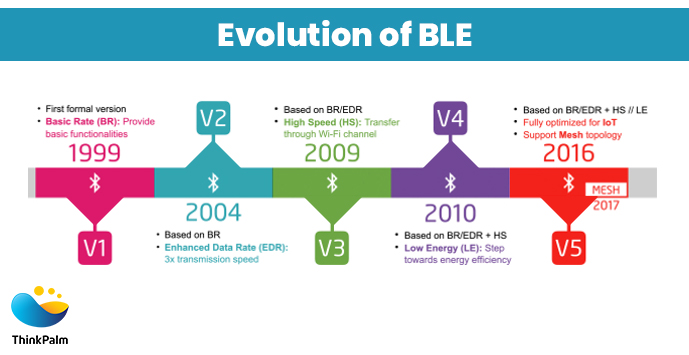 Bluetooth was originally developed by focusing its primary goal of delivering a high throughput data connection. However, modern-day electronics focus more on miniature versions of portable devices, and thus, Bluetooth standards adapted accordingly by shifting focus from merely improving range and data throughput from version 1.0 to version 3.0 towards power efficiency with Bluetooth Low Energy (BLE) in version 4.0 onwards.
Bluetooth was originally developed by focusing its primary goal of delivering a high throughput data connection. However, modern-day electronics focus more on miniature versions of portable devices, and thus, Bluetooth standards adapted accordingly by shifting focus from merely improving range and data throughput from version 1.0 to version 3.0 towards power efficiency with Bluetooth Low Energy (BLE) in version 4.0 onwards.
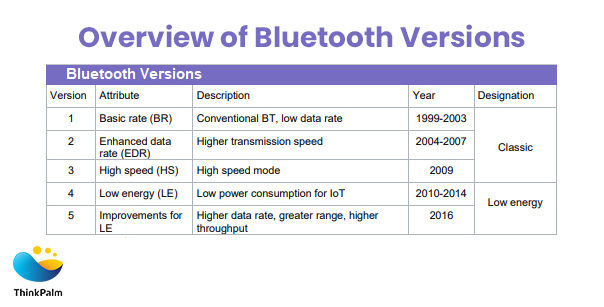 Bluetooth version 4.0 was introduced as a new power-efficient Bluetooth Low Energy (BLE) mode, enabling energy-efficient communications. Subsequently, Bluetooth 4.1 came into being with improved coexistence of LTE mobile networks, better data transfer management, and enhanced privacy features.
Bluetooth version 4.0 was introduced as a new power-efficient Bluetooth Low Energy (BLE) mode, enabling energy-efficient communications. Subsequently, Bluetooth 4.1 came into being with improved coexistence of LTE mobile networks, better data transfer management, and enhanced privacy features.
Bluetooth 4.2 unlocked the real potential of BLE by incorporating security enhancement, Internet of Things (IoT) focused connectivity, enhanced data rate, and support for IPv6.
The current generation Bluetooth standard is version 5.0 with improved IoT features, doubled data transfer speed, quadrupled range, and improved coexistence with wireless technologies like the ‘Dual Audio’ feature.
Later, Bluetooth 5.1, with added direction-finding capabilities, allowed devices to determine the direction of a Bluetooth signal. The key features of Bluetooth 5.2 were improved audio quality, enhanced performance in low-power devices, and updates to the Bluetooth Mesh networking standard.
Bluetooth 5.3 emerged with enhanced features like periodic advertisement interval, channel classification enhancement and encryption key size control enhancements.
Recently, Bluetooth SIG has released Bluetooth 5.4 version with key features as Periodic Advertising with Responses (PAwR), encrypted advertising data and more. As a result, these new enhancements made way for more scalability, energy efficiency, flexibility in topologies and are suitable for bidirectional communication.
The traditional Bluetooth termed Bluetooth Classic and BLE forms part of the Bluetooth standard. They differ in key areas of its application. Bluetooth Classic is ideal for continuous, high-speed data streaming, making it suitable for applications like audio streaming.
However, BLE is optimized to exchange small amounts of data periodically, making it ideal for IoT applications such as sensors, health monitors, fitness devices and many more. Therefore, it is preferable when fast data transfer is required. Data transfer rates are high, up to 1 Mbps and remain in sleep mode constantly except when a connection is initiated.
The Bluetooth device basically consists of a host and a controller. The host is the computing unit of the BT chip. The host runs the Bluetooth stack and the actual application. The two entities communicate over an interface called Host Controller Interface or HCI. The communications include commands from the host to the baseband, events from the baseband to the host, and the data traveling in both directions.
Bluetooth operates within a specific frequency range, known as its Operational Bandwidth (OBW). Both Bluetooth classic and BLE operate in the same frequency range of 2.4GHz (2402 MHz to 2480MHz) ISM (Industrial, Scientific, and Medical) spectrum band, enabling a good balance between range and throughput.
The Bluetooth Classic specification divided the frequency band into 79 channels, each spaced 1MHz apart. Thus, you can find channels numbered from 0 to 78.
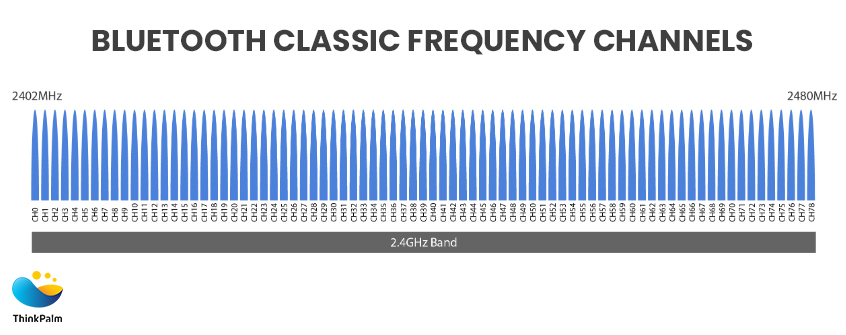 The BLE specification divides the frequency band into 40 channels of 1MHz spaced 2MHz apart. 3 of these channels function as advertising channels. Devices use these channels to send beaconing packets called advertising packets. Also, these packets help find and connect nearby devices.
The BLE specification divides the frequency band into 40 channels of 1MHz spaced 2MHz apart. 3 of these channels function as advertising channels. Devices use these channels to send beaconing packets called advertising packets. Also, these packets help find and connect nearby devices.
Qualification must happen before you take products to market.
A Bluetooth product must be qualified on or before the date you begin to sell or distribute the product. Top of all, this is to ensure interoperability and reinforce the strength of the Bluetooth technology.
Also, the details provided for each Bluetooth product listing must exactly match the product, its packaging markings and marketing materials.
Authorities will take possession of the products if they have not completed the Bluetooth Qualification process. Also, the Bluetooth SIG enforcement actions also follow.
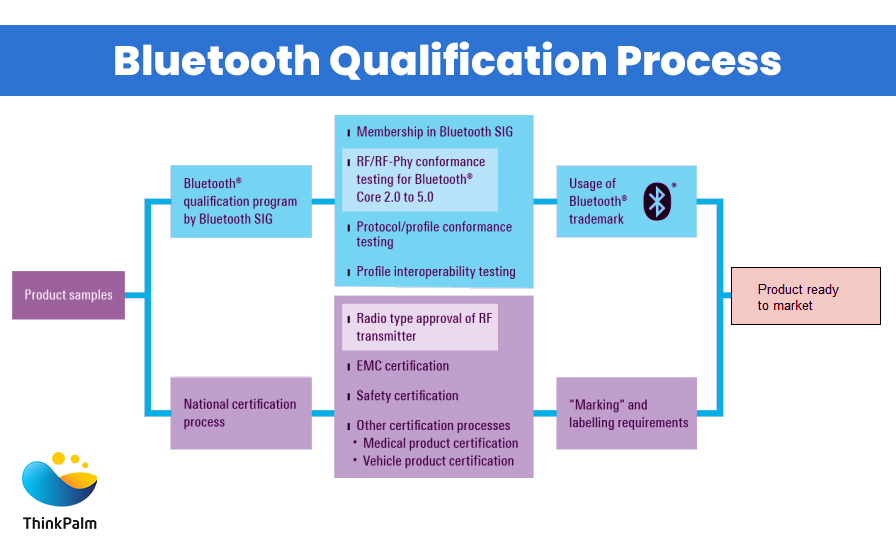 We can divide the Bluetooth qualification process into three dimensions such as
We can divide the Bluetooth qualification process into three dimensions such as
RF/RF-PHY Test – Verify the radio performance of the device
Protocol Conformance Test – Verify the protocol conformance
Profile Test – Verify the relevant specifications, protocol and interoperability
Ellisys Bluetooth Qualifier (EBQ) is a validated test system for qualification, development, validation, and non-regression testing for Bluetooth technology. Moreover, it targets the behavior of lower communication layers.
EBQ supports the most stringent qualification requirements with a powerful and sophisticated hardware and software architecture tailored for the purpose. Additionally, it can support the latest specifications for BLE and Bluetooth Classic. EBQ provides link layer (LL) and host-controller interface (HCI) services and test capabilities to manufacturers that provide qualification services.
In order to acquire the right to embed Bluetooth technology into a designed product, your products must be qualified according to the Bluetooth Qualification Program established by Bluetooth SIG.
The EBQ features a fully embedded architecture that includes real-time processor to manage the low-level stack component and best effort processor to manage high-level stack components and test cases. EBQ is fully autonomous for all test operations, thus optimizing overall performance by dedicating the most powerful hardware and software components.
The EBQ uses a multilayer concept for testing and controlling the IUT. These are the upper tester and the lower tester. The upper tester involves a flexible host controller interface (HCI) connection to the IUT. On the other hand, the lower tester consists of an over-the-air (OTA) interface.
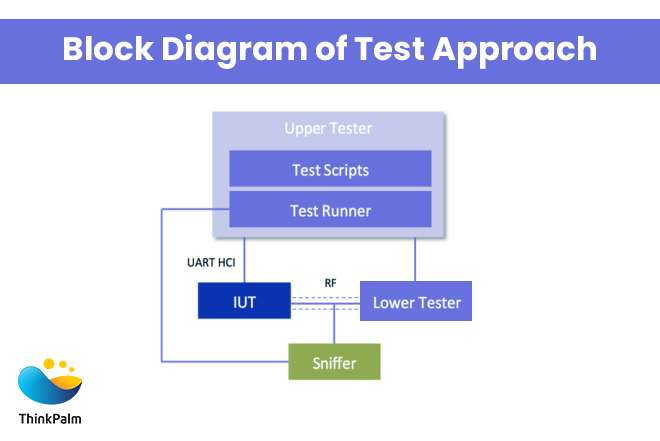 EBQ is a comprehensive compliance, validation, and development system for Bluetooth technology, targeting the behaviors of the lower communication layers by implementing various test cases defined by the Bluetooth SIG.
EBQ is a comprehensive compliance, validation, and development system for Bluetooth technology, targeting the behaviors of the lower communication layers by implementing various test cases defined by the Bluetooth SIG.
Further, Ellisys protocol analyzer offers deep feature sets designed to meet a variety of customer requirements.
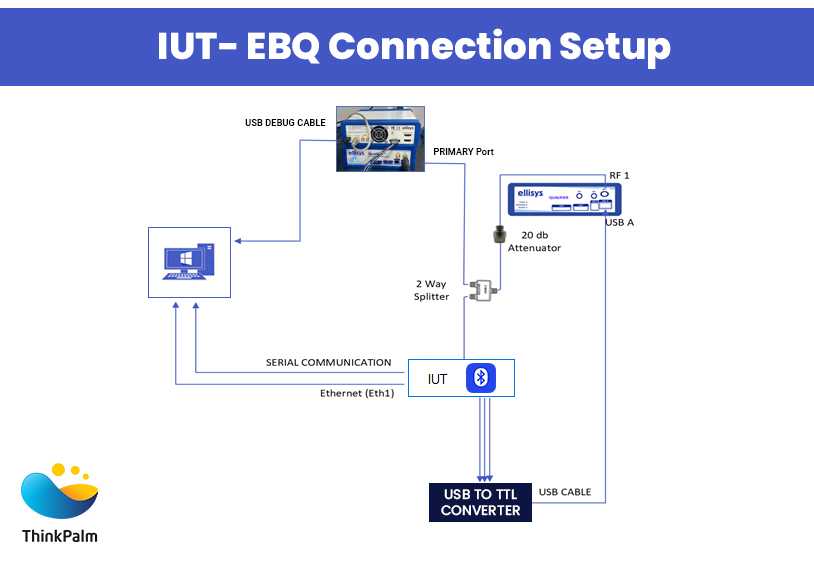 Test Suite Structure (TSS)
Test Suite Structure (TSS)The EBQ supports qualification mandatory test cases for both LE and BR/EDR, included on the Test Case Reference List (TCRL) document published by the Bluetooth SIG. Also, the EBQ software smartly assigns all required test cases to a given Implementation Under Test (IUT).
Host Controller Interface (HCI) is the interface between the upper and lower layers of the Bluetooth protocol stack. Also, the very purpose of HCI testing is to ensure functionality and interoperability between a Bluetooth Controller and a Bluetooth Host in order to enable qualification and combination of controller and host designs. Conformance testing is the appropriate method to meet this intent. Therefore, a conformance test equipment provides a Lower and Upper Tester implementation.
The test objectives verify the functionality of the Isochronous Adaptation Layer (IAL) within a Bluetooth Host. Also, it provides a high probability of air interface interoperability between Bluetooth hosts on different devices.
This test case verifies the implementation of the Bluetooth Low Energy Link Layer (LL). Thus, it features high probability of air interface interoperability and functionality between the tested implementation and other Bluetooth devices. The intent is to test mandatory and optional LL requirements and their combinations based on protocol specifications.
The test case reflects the protocol procedure for device discovery, connection handling, and security. Also, it covers testing for specific aspects such as timing, formats, and frequency hopping in any of the protocol procedures.
These test cases verify the implementation of the Bluetooth Baseband (BB) layer. Therefore, it has the objective of providing a high probability of air interface interoperability between the tested implementation and other Bluetooth devices.
This test case is to test the implementation of the Bluetooth Link Manager layer. Moreover, the objective of this test is to provide a high probability of air interface interoperability between the tested implementation and other Bluetooth devices.
Besides, the LMP specifies seven groups of services such as
Operated by an ingenious software application, the EBQ monitors qualification and development workflows.
Furthermore, the EBQ makes all pass/fail decisions in real-time and offers an elaborate summary of all test activities.
As a result, after the successful run of testing, it generates a summary of the test report showing all relevant test results. It helps submit the generated details to the Bluetooth Special Interest Group (SIG) for certification purposes.
ThinkPalm offers Bluetooth Qualification testing with Ellisys Bluetooth Qualifier (EBQ) and Ellisys Bluetooth Explorer to carry out Bluetooth Qualification Body (BQB) tests to ensure the Bluetooth product complies with Bluetooth standards.
More importantly, our EBQ platform supports all the latest versions of Bluetooth Core Specification.
Also, our system of Bluetooth testing and test support services cover:
Radio Frequency (RF)
Baseband
Link Manager
Protocol Conformance
Profile Conformance
One thing is sure: In the future, Wi-Fi, plus Bluetooth technologies, will let you connect to the Internet directly, making it the most adaptable technology for your IoT products.